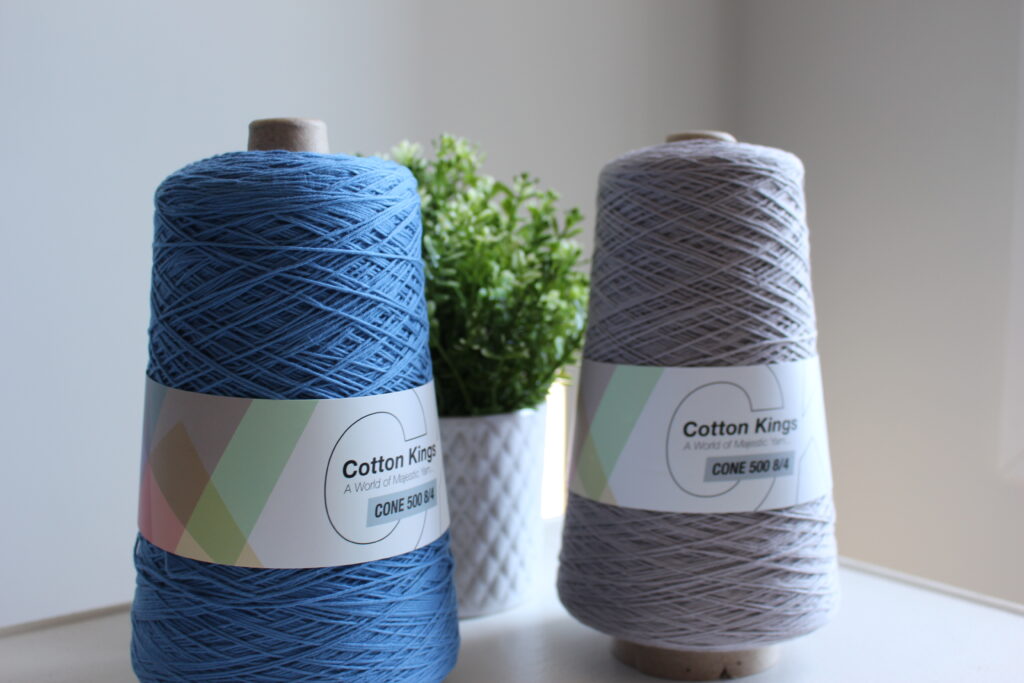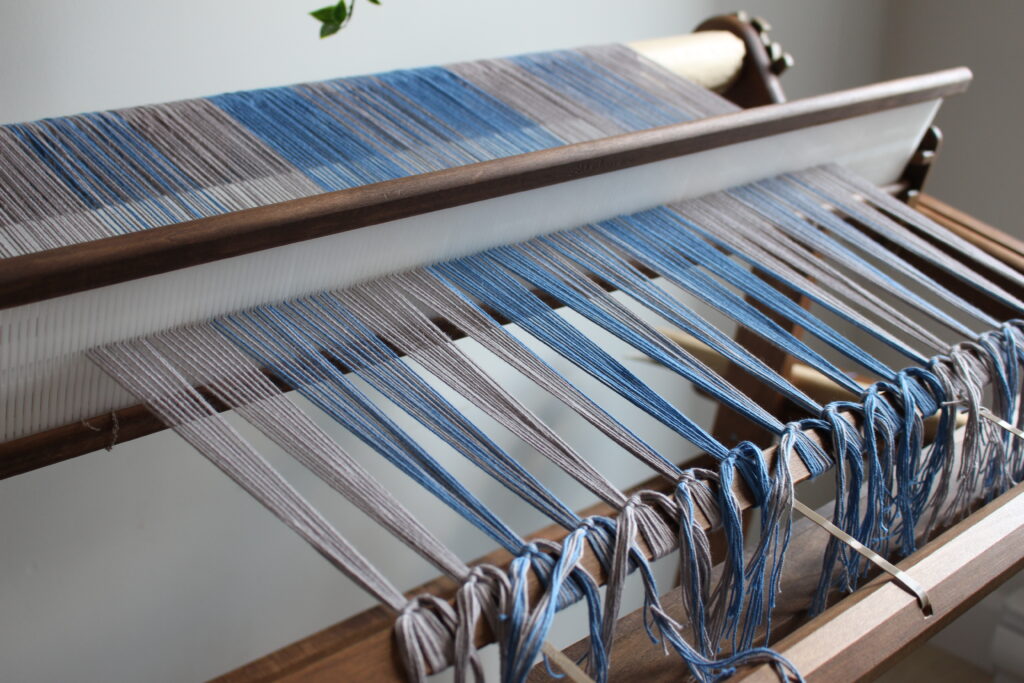Warping for Dishtowels with 8/4 Cotton
I believe that there are as many ways to make dishtowels as there are weavers! Everybody has their own preferences and their own perks when weaving them. Myself, I like my towels thin! This has led me to adopt thin 8/2 cotton yarns. I use them ALL the time! However today, I’m going out of my comfort zone and I’m trying something new: warping for dishtowels with 8/4 cotton on my rigid heddle loom. This means that there will be two parts to this project. For the first one, I will be only talking about the warping of this project. There will then be another one in a few weeks in which I will be sharing the weaving of those dishtowels.
Here’s the video I made about this project:
Fist, let me put you in context on how this project started. A few weeks agao, I bought a huge stash of yarn from Hobbii. I had always been curious about their yarn and I was excited to try a lot of them. I have already made a scarf with one of their cake yarn. However, I have not made a blog post about it yet, but it’s possible to see this project in the following video:
Also, I had heard that Hobbii made amazing cotton yarns for dishtowels, and I was really curious to try them. However, when I browsed through their website, I realized that they did not make them 8/2 cotton, my favorite size. So I decided to buy two cones of their 8/4 cotton and see if I liked working with them. This means that with this project, I’m open to this new yarn and to trying out thicker towels!

For disclaimer, links included on this page might be affiliate links. This means that if you purchase a product or service with the links that I provide, I may receive a small commission. Please note that there is no additional charge to you. This is just a way for me to keep making this content. Thank you for your support!
8/2 Cotton vs 8/4 Cotton
Before starting the project, let’s have a little discussion about the differences between 8/2 and 8/4 cotton and why I usually prefer one more than the other.

In a nutshell, 8/2 cotton is a thinner yarn and than 8/4 cotton. It’s as simple as that. This being said, the reason why I prefer 8/2 cotton is that I find it more versatile. Apart from my rigid heddle loom, I have two multi-shaft looms and I prefer to weave with thinner yarns on them. This means 8/2 cotton, but also 8/2 Tencel, bamboo, etc. Also, when I go to the store, I simply buy yarns that I like, without always having a specific project in mind. When I’m ready to start a project, this is when I go to my stash and get inspired by all of the yarns that I have. This means that I have a tendency to only buy 8/2 cotton as I know that I might use it on any of my three looms.
Also, I love my towels thin. This doesn’t bother me at all to weave thinner towels on my rigid heddle loom!
I do not believe that there is a difference in absorbency between 8/2 and 8/4 cotton. For me, my preference really comes from their utility.
The Yarn
Here’s more details about the yarn used for this project. As I mentioned before, I’m trying for the first time to make dishtowels with yarn from Hobbii. For the colors, I have decided to go with a light gray, which name is “Ash” (07) and a light blue which name is “Cornflower” (17). And of course, their size is 8/4 and they are made out of 100% cotton.

Here’s a link to Hobbii’s website, where you can get the same yarn:
The cones are pretty massive and each of them contains around 1700m (1856yds) of yarn. I should be able to make a few projects out of them!
The specifics
For this project, I used my 12.5 DPI heddle and I singled my threads in each dent. I have warped a width of 23.5” (58cm) and the project has 294 ends. At first, I wanted my project to be exactly 24” (60cm) wide and to have 300 ends. However, in order for the pattern to work, I had to remove a few ends.
I warped a length of about 100” (2.5m). At the moment of warping, I believed that this should be enough to weave 2 dishtowels of about 40” (1m) long each and allow for about 22” (50cm) of waste yarn. Now that the project is done, I can say that I ended up having a little less scrap yarn than that, which allowed me to leave about 4” of fringes in between my woven towels. If I were to redo this project, I would probably warp for about 4” (10cm) longer just to have a bit more wiggle room and have both towels the same size. My advice, warp for 104″ (2.6m).
The Warp Pattern
The concept of my warp pattern is to have three similar blocks of colors in which I alternate the colors. Inside of those blocks of colors, I have added a part that will be woven into a houndstooth pattern. Here’s a screen shot of my excel file to give you an idea of my plan. If you wish to learn more about how I plan my warp patterns using a spreadsheet, you can check out this page.
As I mentioned, there are three blocks of pattern in this project and two of them are the same. Basically, we have the gray block and the blue block. The gray block is done twice; once on the left side and once on the right side of the pattern. And the blue block is done once, in the middle of the pattern.

Here’s the detailed thread count of the pattern. I like to give indications in terms loops pulled and threads. I find that if you are direct warping your loom, it makes more sense to talk in terms of loops pulled. However, if you are indirect warping your loom, I find it makes more sense to talk in terms of threads.
The Gray Block
-16 loops (32 threads) of gray
-*1 loop of blue, 1 loop of gray* (2 threads of blue, 2 threads of gray) repeat the sequence between the * 8 times
-1 loop of blue (2 threads) (see the note below)
-16 loops (32 threads) of gray
Note: The houndstooth part of the pattern contains 17 ends. This means 9 blue threads and 8 gray threads.
The Blue Block
The blue block is simply the reverse of the gray block. Here’s the details:
-16 loops (32 threads) of blue
-*1 loop of gray, 1 loop of blue* (2 threads of blue, 2 threads of gray) repeat the sequence between the * 8 times
-1 loop of gray (2 threads) (see the note below)
-16 loops (32 threads) of blue
Note: The houndstooth part of the pattern contains 17 ends. This means 9 blue gray threads and 8 blue threads.

A Little Tip
When warping for houndstooth with the direct method, we pull a loop of each color alternatively. If you are new to weaving, I’m going to give out a little tip: You do not have to cut and attach your yarn each time that you change color. This would be way too much work! You can actually work with both threads attached to the back apron of your loom simultaneously. You simply have to pick them one by one and leave the other one hanging there. The yarn will naturally cross over each other around the back apron. Since that this is done one loop at a time, it usually doesn’t create any tension issue because the threads don’t have to travel far to reach their next dent.
Moreover, if you feel like your threads tend to tangle together when you pull on one of the yarns; simply put the cones further away from each other. They need space in order to unwind properly!

In Conclusion
The warping of dishtowels with 8/4 cotton was easy! I’m starting to really like this yarn. Behind the simple design I created, I will have towels will surely have a stunning look.
Now that the warping is done, here’s the post about the weaving of those towels: Weaving Houndstooth Dishtowels with 8/4 Cotton
Trying to find the info on your weaving lamp but can not find the notes
I’m sorry, the info was only in my video description. Here’s the link to BenQ’s website where you can get all the details about the lamp: https://www.benq.com/en-us/lighting/e-reading-desk-lamp/e-reading.html
And here’s the link to the product on Amazon(note that my lamp is the “Swing Arm Desk Lamp”) https://www.amazon.com/BenQ-Reading-LED-Desk-Lamp/dp/B0178HLTXO/
Good info! Thanks. I’ve been using 8/4 exclusively, but my towels were too small, more like tea towels. I’ll use your recommendations on my next towels.
Thank you! 🙂 I wish you good luck with your next towels. Let me know how they go!
Hi, I am really enjoying your videos! I am getting back into rigid heddle weaving after 10 years! I got a 32” Ashford rigid heddle good for Christmas! It comes with a 7.5 heddle. I have a lot of 8/2 and 8/4 cotton for dish towels, you are using a 12.5 heddle in the towel pattern above. I want to get more heddles, is the 12.5 one that will work with 8.2 yarn too? I’m having trouble trying to figure out which heddles and yarn work together!!!
Thanks for all the help!!
Congrats on your new loom! The 12,5 heddle could work with 8/2 cotton too. However, please note that in that case, it would be better the double the warp threads. I have a few videos that explain how to do it. This will make a towel that’s nice and thick! At the end, it all comes down to personnal preferences.
Enjoyed your video. Thanks for using some of hobbii’s yarn for some projects. Their yarn is so affordable, but for beginners as I am this is really helpful. Thanks again. Shirley
Thank you so much for you nice comment! I’m glad to know you appreciate it!